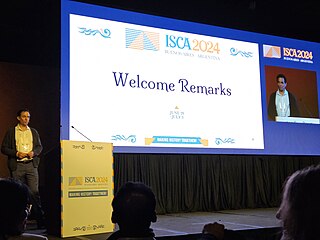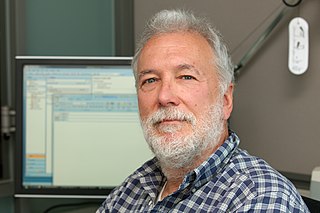Related Research Articles

John Leroy Hennessy is an American computer scientist who is chairman of Alphabet Inc. (Google). Hennessy is one of the founders of MIPS Technologies and Atheros, and also the tenth President of Stanford University. Hennessy announced that he would step down in the summer of 2016. He was succeeded as president by Marc Tessier-Lavigne. Marc Andreessen called him "the godfather of Silicon Valley."

Joseph A "Josh" Fisher is an American and Spanish computer scientist noted for his work on VLIW architectures, compiling, and instruction-level parallelism, and for the founding of Multiflow Computer. He is a Hewlett-Packard Senior Fellow (Emeritus).

Yale Nance Patt is an American professor of electrical and computer engineering at The University of Texas at Austin. He holds the Ernest Cockrell, Jr. Centennial Chair in Engineering. In 1965, Patt introduced the WOS module, the first complex logic gate implemented on a single piece of silicon. He is a fellow of both the Institute of Electrical and Electronics Engineers and the Association for Computing Machinery, and in 2014 he was elected to the National Academy of Engineering.
The Eckert–Mauchly Award recognizes contributions to digital systems and computer architecture. It is known as the computer architecture community’s most prestigious award. First awarded in 1979, it was named for John Presper Eckert and John William Mauchly, who between 1943 and 1946 collaborated on the design and construction of the first large scale electronic computing machine, known as ENIAC, the Electronic Numerical Integrator and Computer. A certificate and $5,000 are awarded jointly by the Association for Computing Machinery (ACM) and the IEEE Computer Society for outstanding contributions to the field of computer and digital systems architecture.
Wen-mei Hwu is a Taiwanese-American computer scientist. He is the Senior Director of Research and Senior Distinguished Research Scientist at NVIDIA Corporation as well as the Walter J. Sanders III-AMD Endowed Chair Professor Emeritus in Electrical and Computer Engineering at the University of Illinois at Urbana-Champaign.
Joel McCormack is an American computer scientist who designed the NCR Corporation version of the p-code machine, which is a kind of stack machine popular in the 1970s as the preferred way to implement new computing architectures and languages such as Pascal and BCPL. The NCR design shares no common architecture with the Pascal MicroEngine designed by Western Digital but both were meant to execute the UCSD p-System.[1,2]
David J. Kuck, a graduate of the University of Michigan, was a professor in the Computer Science Department the University of Illinois at Urbana-Champaign from 1965 to 1993. He is the father of Olympic silver medalist Jonathan Kuck. While at the University of Illinois at Urbana-Champaign he developed the Parafrase compiler system (1977), which was the first testbed for the development of automatic vectorization and related program transformations. In his role as Director (1986–93) of the Center for Supercomputing Research and Development (CSRD-UIUC), Kuck led the construction of the CEDAR project, a hierarchical shared-memory 32-processor SMP supercomputer completed in 1988 at the University of Illinois.

The International Symposium on Computer Architecture (ISCA) is an annual academic conference on computer architecture, generally viewed as the top-tier in the field. Association for Computing Machinery's Special Interest Group on Computer Architecture and Institute of Electrical and Electronics Engineers Computer Society are technical sponsors.

Mark A. Horowitz is an American electrical engineer, computer scientist, inventor, and entrepreneur who is the Yahoo! Founders Professor in the School of Engineering and the Fortinet Founders Chair of the Department of Electrical Engineering at Stanford University. He holds a joint appointment in the Electrical Engineering and Computer Science departments and previously served as the Chair of the Electrical Engineering department from 2008 to 2012. He is a co-founder, the former chairman, and the former chief scientist of Rambus Inc.. Horowitz has authored over 700 published conference and research papers and is among the most highly-cited computer architects of all time. He is a prolific inventor and holds 374 patents as of 2023.
Thomas Martin Conte is the Associate Dean for Research and Professor of Computer Science at Georgia Institute of Technology College of Computing; and, since 2011, also Professor of Electrical and Computer Engineering at Georgia Institute of Technology College of Engineering. He is a fellow of Institute of Electrical and Electronics Engineers (IEEE). He served as the president of the IEEE Computer Society in 2015.

James Richard "Jim" Goodman retired as professor of computer science at the University of Auckland in Auckland, New Zealand, and emeritus professor at the University of Wisconsin–Madison.
Edward S. Davidson is a professor emeritus in Electrical Engineering and Computer Science at the University of Michigan, Ann Arbor.
The Computer Entrepreneur Award was created in 1982 by the IEEE Computer Society, for individuals with major technical or entrepreneurial contributions to the computer industry. The work must be public, and the award is not given until fifteen years after the developments. The physical award is a chalice from sterling silver and under the cup a gold-plated crown.

Oyekunle Ayinde "Kunle" Olukotun is a British-born Nigerian computer scientist who is the Cadence Design Systems Professor of the Stanford School of Engineering, Professor of Electrical Engineering and Computer Science at Stanford University and the director of the Stanford Pervasive Parallelism Lab. Olukotun is known as the “father of the multi-core processor”, and the leader of the Stanford Hydra Chip Multiprocessor research project. Olukotun's achievements include designing the first general-purpose multi-core CPU, innovating single-chip multiprocessor and multi-threaded processor design, and pioneering multicore CPUs and GPUs, transactional memory technology and domain-specific languages programming models. Olukotun's research interests include computer architecture, parallel programming environments and scalable parallel systems, domain specific languages and high-level compilers.
Margaret Rose Martonosi is an American computer scientist who is currently the Hugh Trumbull Adams '35 Professor of Computer Science at Princeton University. Martonosi is noted for her research in computer architecture and mobile computing with a particular focus on power-efficiency.
Susan J. Eggers is an American computer scientist noted for her research on computer architecture and compilers.
Cache prefetching is a technique used by computer processors to boost execution performance by fetching instructions or data from their original storage in slower memory to a faster local memory before it is actually needed. Most modern computer processors have fast and local cache memory in which prefetched data is held until it is required. The source for the prefetch operation is usually main memory. Because of their design, accessing cache memories is typically much faster than accessing main memory, so prefetching data and then accessing it from caches is usually many orders of magnitude faster than accessing it directly from main memory. Prefetching can be done with non-blocking cache control instructions.
Kimberly Kristine Keeton is an American computer scientist specializing in databases and computer data storage. She worked at HP Labs as a Distinguished Technologist and is currently employed by Google as Principal Engineer, and was one of the designers of the Express Query metadata database used by Hewlett-Packard as part of their StoreAll large-scale data storage systems.
Mark D. Hill is a computer scientist and professor at the University of Wisconsin–Madison. He has been cited over 27,000 times.
Trevor Mudge is a computer scientist, academic and researcher. He is the Bredt Family Chair of Computer Science and Engineering, and Professor of Electrical Engineering and Computer Science at the University of Michigan.
References
- ↑ Norman Paul Jouppi. Timing verification and performance improvement of MOS VLSI designs. Stanford Library SearchWorks catalog (Thesis).
- ↑ Jouppi, Norman (1990). "Improving direct-mapped cache performance by the addition of a small fully-associative cache and prefetch buffers". Proceedings of the 17th annual international symposium on Computer Architecture - ISCA '90. pp. 364–373. doi: 10.1145/325164.325162 . ISBN 0897913663.
- ↑ "Eckert Mauchly Award 2015" (PDF). Archived from the original (PDF) on 2015-09-06. Retrieved 2019-08-25.
- ↑ "IEEE Fellows 2003 | IEEE Communications Society".